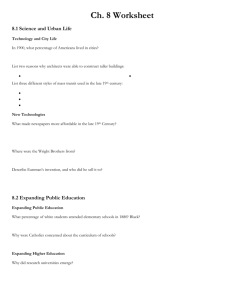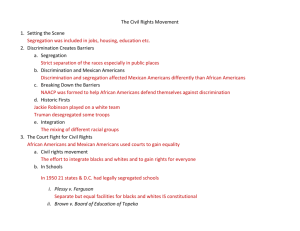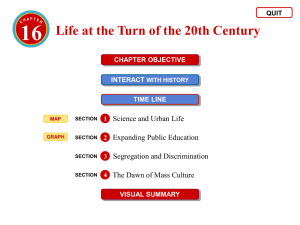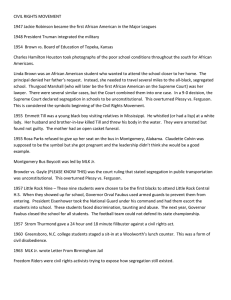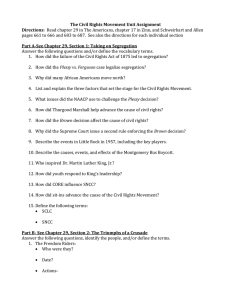Chapter 8 Notes
advertisement
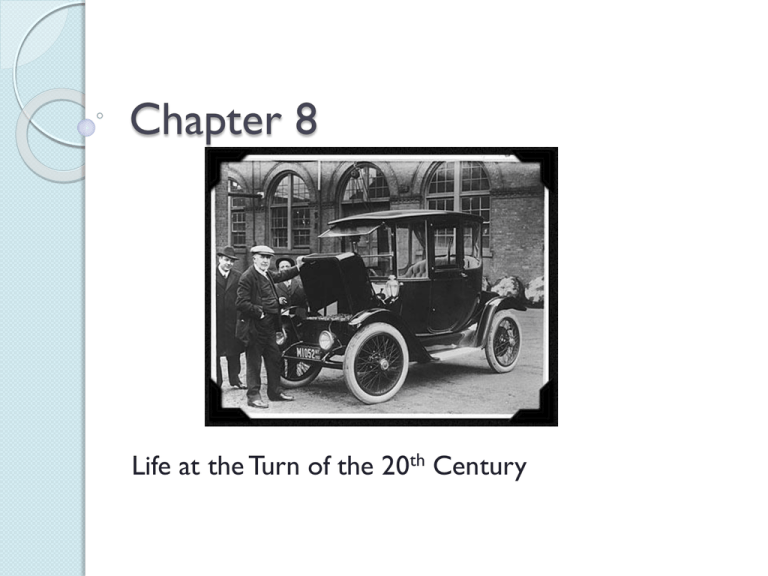
Chapter 8 Life at the Turn of the 20th Century 1.Science and Urban Life Technology and City Life ◦ Skyscrapers Phrase coined by Louis Sullivan Elevators + steel frames ◦ Electric Transit –electric trolleys, elevated trains, underground railways ◦ Engineering and Urban Planning People need open spaces in which they can relax: parks, zoos, sports centers, bicycle paths Example: Central Park 1.Science and Urban Life New Technologies ◦ Printing web-perfecting printed on both sides, cut, folded, and counted pages Printed material produced faster and cheaper ◦ Airplanes Orville and Wilbur Wright December 17, 1903 –first successful flight; 120 feet, 12 seconds ◦ Photography Cameras developed for the masses George Eastman –Kodak camera 2.Expanding Public Education Expanding Public Education ◦ Late 1800s:state laws declare 12-16 weeks of school required per year for children ages 8-14. ◦ High schools offer technical training ◦ African Americans typically denied access to public secondary schools; between 1&3% attend high school between 1890 and 1900 ◦ Immigrants encouraged to go to school and become “Americanized” 2. Expanding Public Education Expanding Higher Education ◦ 1880-1920: college enrollments quadruple ◦ Research universities Psychology, sociology, physical sciences, modern languages 2. Expanding Education Higher Education for African Americans ◦ 1865-1868: Howard, Atlanta, and Fisk Universities founded by African Americans ◦ Problem: not enough African American students can afford to go to college and financial support from private donors was insufficient ◦ 1900: 3,880/9,000,000 African Americans attended college or professional school 2. Expanding Education A Tale of Two Educators: ◦ Booker T. Washington: African Americans must acquire useful labor skills and prove their economic value Founded Tuskegee Normal and Industrial Institute ◦ W.E.B. Du Bois: First African American to receive a doctorate from Harvard Niagara Movement: African American community needs well-educated leaders; African Americans should seek a liberal arts education “Talented Tenth” 3.Segregation and Discrimination Voting Restrictions: ◦ Literacy tests: African Americans asked more difficult questions or given tests in a foreign language ◦ Poll Tax: sharecroppers (both black and white) often too poor to pay it ◦ Grandfather Clause: ensured that whites who a)failed the literacy test or b)couldn’t pay the poll tax, could still vote. The Rule: If a man, his father, or his grandfather had been eligible to vote before January 1, 1867, he did not have to pay the poll tax or pass the literacy test. *Note: before this date, freed slaves did not have the right to vote. 3.Segregation and Discrimination 1870s/80s: Southern states put racial segregation laws (Jim Crow Laws)into effect. ◦ Schools, hospitals, parks, and transportation systems become segregated. 3.Segregation and Discrimination Plessy v. Ferguson: Supreme Court rules that separation of races in public places was legal and did not violate the 14th Amendment. ◦ Established the “separate but equal” doctrine. ◦ This decision ensured the legalization of segregation for almost 60 more years. 3.Segregation and Discrimination Turn of the Century Race Relations “racial etiquette” –informal rules and customs ◦ No hand-shaking between whites and blacks – would have implied equality ◦ African Americans had to yield to white pedestrians on sidewalks ◦ Black men had to remove their hats for whites 3.Segregation and Discrimination Some moderate reformers (Booker T. Washington) gained support from whites. “…In all things that are purely social we can be as separate as the fingers, yet one as the hand in all things essential to mutual progress.” –Booker T. Washington Washington hoped that improving the economic skills of African Americans would help them make long-term gains. 3.Segregation and Discrimination Violence: Those who broke the rules of racial etiquette faced severe punishment or death –usually by lynching. 1882-1892: more than 1,400 African American men and women were shot, burned, or hanged without trial. Ida B. Wells –investigative journalist who fought against lynching 3.Segregation and Discrimination Discrimination in the North ◦ Neighborhoods ◦ Labor unions ◦ Job market Tension sometimes culminated in race riots 3.Segregation and Discrimination Discrimination in the West ◦ Mexican Workers Many hired to build railroads in the Southwest Paid lower than other ethnic groups Some forced into debt peonage* –a system which bound laborers into slavery in order to work off a debt to the employer. *the Supreme Court outlawed this in 1911 because it violated the 13th Amendment The Dawn of Mass Culture American Leisure ◦ ◦ ◦ ◦ Amusement Parks Bicycling Tennis Spectator Sports Baseball The Dawn of Mass Culture Popular New Products ◦ Hershey Chocolate Bar ◦ Coca-Cola 4.The Dawn of Mass Culture The Spread of Mass Culture ◦ Mass Circulation Newspapers Joseph Pulitzer –owner of the New York World; emphasized, “sin, sex, and sensation.” William Randolph Hearst –owner of New York Morning Journal; exaggerated tales of personal scandals, cruelty, hypnotism, and on one occasion, an imaginary conquest of Mars. 4.The Dawn of Mass Culture Promoting the Fine Arts ◦ Art Museums more common ◦ Ashcan School: group of artists who often painted realistic pictures of city life (tenements, homeless people, etc.) Ashcan School Art George Bellows, Cliff Dwellers Ashcan School Art George Bellows; Both Members of this Club 4.The Dawn of Mass Culture Popular Fiction ◦ Most people like to read light fiction (mysteries, adventure, etc.) Samuel Clemens aka Mark Twain ◦ The Adventures of Huckleberry Finn 4.The Dawn of Mass Culture New Ways to Sell Goods ◦ ◦ ◦ ◦ ◦ ◦ Urban Shopping The Department Store The Chain Store Advertising Catalogs Rural Free Delivery: free government delivery of mail and packages to homes in rural areas
